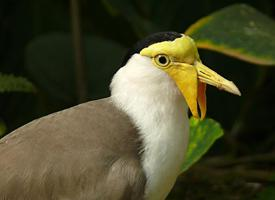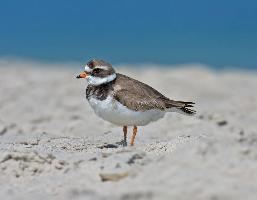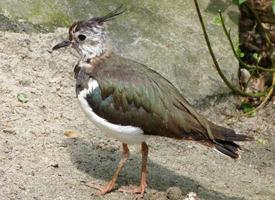
Poids et mesures
| Longueur | de 33 à 37 cm |
|---|---|
| Poids | 400 g |
Description de l'animal
The Masked Lapwing, scientifically known as Vanellus miles, is a distinctive and fascinating bird native to Australia, particularly widespread in the northern and eastern parts of the continent. It is also found in New Zealand, where it is known as the Spur-winged Plover, and in New Guinea. This bird belongs to the lapwing family, which is characterized by its wading habits and preference for ground nesting.The Masked Lapwing is a medium-sized bird, measuring about 35 to 38 cm in length, and is particularly noted for its striking appearance. It has a predominantly white underside, contrasting sharply with its black back and wings. The wings are also tipped with a prominent white color, which becomes highly visible during flight. The most distinctive features of the Masked Lapwing, however, are its bright yellow face, large yellow wattles (fleshy lobes) hanging down from the sides of its head, and the long, yellow spurs on its wings, which are used for defense, especially during the breeding season.
These birds are highly adaptable and can be found in a variety of habitats, including grasslands, wetlands, mudflats, and even urban areas such as parks and golf courses. They feed mainly on insects and other small invertebrates, which they find by foraging on the ground. Their diet includes a variety of worms, beetles, and larvae.
Masked Lapwings are known for their aggressive behavior, especially during the breeding season, which typically runs from August to October. They are ground-nesters, laying their eggs in a simple scrape on the ground, often in surprisingly open areas. Both parents are highly protective of the nest and will aggressively defend their territory against any perceived threats, including humans and other animals, often swooping down and using their spurs or emitting loud, piercing calls to scare away intruders.
The bird's call is another distinctive feature; it is a loud, penetrating "kekekekeke" sound that can be heard at night and during the day. This call, combined with their aggressive defense of their nesting area, makes the Masked Lapwing a notable presence in its habitat.
In terms of social structure, Masked Lapwings are often seen in pairs or small groups, although larger flocks may gather in suitable feeding areas. After the breeding season, the protective behavior subsides, and the birds become more tolerant of others in their vicinity.
Conservation-wise, the Masked Lapwing is currently not considered to be at risk. Its ability to adapt to a variety of habitats, including those altered by human activity, has allowed its population to remain stable and widespread. However, as with all wildlife, maintaining healthy habitats is crucial for the continued prosperity of the species.
In summary, the Masked Lapwing is a unique and captivating bird, notable for its distinctive appearance, aggressive behavior during breeding season, and adaptability to various environments. Its presence across a wide range of habitats in Australia and neighboring countries makes it a familiar sight to many, contributing to the rich biodiversity of the region.
Animaux similaires
Nouvelles photos d'animaux
Top 10 des animaux
- Dolphin gull (Leucophaeus scoresbii)
- Diana monkey (Cercopithecus diana)
- Moustached guenon (Cercopithecus cephus)
- Galápagos tortoise (Geochelone nigra complex)
- Stone loach (Barbatula barbatula)
- Japanese macaque (Macaca fuscata)
- Russian tortoise (Testudo horsfieldii)
- Greek tortoise (Testudo graeca)
- Common flying dragon (Draco volans)
- Vendace (Coregonus albula)


